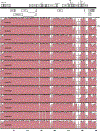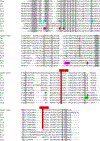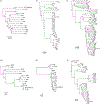Genomic characterization of human adenovirus 36, a putative obesity agent
- PMID: 20109503
- PMCID: PMC7021214
- DOI: 10.1016/j.virusres.2010.01.011
Genomic characterization of human adenovirus 36, a putative obesity agent
Abstract
Increased levels of serum antibody titers against human adenovirus 36 (HAdV-D36) are associated with human obesity and experimental obesity in laboratory animals. While HAdV-D36 has been studied as an infectious agent implicated in obesity for over a decade, the complete genome sequence and its analysis have yet to be reported. A detailed analysis of the genome sequence of HAdV-D36 may be important to understand its role in obesity. Genomic and bioinformatic comparisons with other HAdVs identified differences that suggested unique functions. Global pairwise genome alignment with all sequenced human adenovirus D (HAdV-D) genomes revealed areas of nonconserved sequences in the hexon, E3 CR1 beta, E3 CR1 gamma, and fiber genes. Phylogenetic analysis of all HAdV-D36 proteins confirmed that this virus belongs to species Human adenovirus D. This genomic analysis of HAdV-D36 provides an important tool for comprehending the role that this unique adenovirus may play in human obesity. Low amino acid sequence identity in the E3 CR1 beta and CR1 gamma genes may suggest distinctive roles for these proteins. Furthermore, the predicted molecular models of the HAdV-D36 fiber protein seem to implicate a unique tissue tropism for HAdV-D36.
(c) 2010 Elsevier B.V. All rights reserved.
Figures








Similar articles
-
Genomic and bioinformatics analysis of human adenovirus type 37: new insights into corneal tropism.BMC Genomics. 2008 May 9;9:213. doi: 10.1186/1471-2164-9-213. BMC Genomics. 2008. PMID: 18471294 Free PMC article.
-
Computational analysis of two species C human adenoviruses provides evidence of a novel virus.J Clin Microbiol. 2011 Oct;49(10):3482-90. doi: 10.1128/JCM.00156-11. Epub 2011 Aug 17. J Clin Microbiol. 2011. PMID: 21849694 Free PMC article.
-
Complete genome analysis of a novel intertypic recombinant human adenovirus causing epidemic keratoconjunctivitis in Japan.J Clin Microbiol. 2011 Feb;49(2):484-90. doi: 10.1128/JCM.01044-10. Epub 2010 Dec 8. J Clin Microbiol. 2011. PMID: 21147954 Free PMC article.
-
Human adenovirus type 8: the major agent of epidemic keratoconjunctivitis (EKC).J Clin Virol. 2014 Dec;61(4):477-86. doi: 10.1016/j.jcv.2014.10.015. Epub 2014 Nov 4. J Clin Virol. 2014. PMID: 25464969 Review.
-
Genomic Evolution and Recombination Dynamics of Human Adenovirus D Species: Insights from Comprehensive Bioinformatic Analysis.J Microbiol. 2024 May;62(5):393-407. doi: 10.1007/s12275-024-00112-5. Epub 2024 Mar 7. J Microbiol. 2024. PMID: 38451451 Review.
Cited by
-
Long-term infection passaging of Human Adenovirus 36 in monkey kidney cells.Rev Inst Med Trop Sao Paulo. 2022 Nov 14;64:e68. doi: 10.1590/S1678-9946202264068. eCollection 2022. Rev Inst Med Trop Sao Paulo. 2022. PMID: 36383890 Free PMC article.
-
Presence of Adenovirus-36 DNA in Adipose Tissue of Women: Relationship with Adipocyte Morphology and the Expression of C/EBPβ and HIF-1α.Diabetes Metab Syndr Obes. 2021 Feb 3;14:477-486. doi: 10.2147/DMSO.S285341. eCollection 2021. Diabetes Metab Syndr Obes. 2021. PMID: 33568924 Free PMC article.
-
Predicting the next eye pathogen: analysis of a novel adenovirus.mBio. 2013 Apr 9;4(2):e00595-12. doi: 10.1128/mBio.00595-12. mBio. 2013. PMID: 23572555 Free PMC article.
-
Computational analysis and identification of an emergent human adenovirus pathogen implicated in a respiratory fatality.Virology. 2011 Jan 20;409(2):141-7. doi: 10.1016/j.virol.2010.10.020. Epub 2010 Nov 5. Virology. 2011. PMID: 21056888 Free PMC article.
-
Beyond fast food and slow motion: weighty contributors to the obesity epidemic.J Endocrinol Invest. 2012 Feb;35(2):236-42. doi: 10.3275/8182. Epub 2011 Dec 15. J Endocrinol Invest. 2012. PMID: 22183119 Free PMC article. Review.
References
-
- Atkinson RL, Dhurandhar NV, Allison DB, Bowen RL, Israel BA, Albu JB, Augustus AS, 2005. Human adenovirus-36 is associated with increased body weight and paradoxical reduction of serum lipids. Int. J. Obes. (Lond.) 29 (3), 281–286. - PubMed
-
- Brown WV, Fujioka K, Wilson PW, Woodworth KA, 2009. Obesity: why be concerned? Am. J. Med 122 (4 (Suppl. 1)), S4–S11. - PubMed
Publication types
MeSH terms
Substances
Associated data
- Actions
Grants and funding
LinkOut - more resources
Full Text Sources
Other Literature Sources

